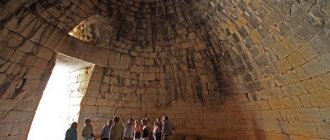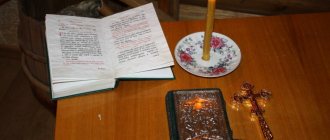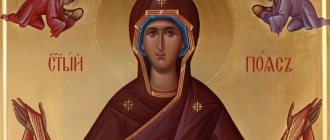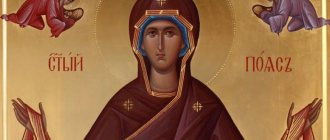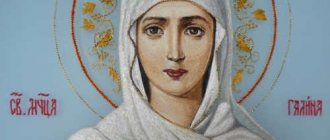Manifestations of the Divine
The pagan and Christian periods of color symbolism are significantly different. With the advent of Christianity, color and light are no longer interpreted as deities, mystical forces, but turn into their attributes, qualities and signs.
According to Christian legend, the whole world was created by the Lord, including color and light. However, God himself is not identified with them. In their praises of light and color, medieval theologians point out that colors can have a deceptive essence (from the devil) and their identification with the Lord is considered a sin.
The meaning of the Star of Lada amulet for women
The ancient Slavs believed in the purpose of people and their responsibilities to the Family. The woman was obliged to run the household, take care of the children and give wise advice to her husband. To preserve spiritual strength for all this, the Slavs turned to their patroness Lada the Mother of God for help.
The Goddess only supports those girls who are sincere in their prayers. With its help, it will not be possible to harm someone or implement an evil plan. Lada is a light goddess, so she does not know evil and dark thoughts.
The main meaning of the Slavic amulet Star of Lada for women is fertility. This applies to both a rich harvest and numerous and healthy offspring.
The amulet helps a girl meet a good groom, get pregnant without problems, carry and give birth to a child. It helps married women maintain love and passion in marriage, as well as become an ideal wife.
The talisman helps only those girls who put the interests of family and children first. It will not work for attracting good luck in career, lotteries and other money matters. The amulet protects widows and orphans, but is not suitable for little girls whose feminine energy is just awakening.
For men, the Star of Lada amulet does not provide any benefit. Its energy does not affect the stronger sex, so men can wear the sign only as decoration.
But women who regularly resort to the help of the Goddess Lada will receive help:
- in building a strong marriage for life;
- maintaining harmony and quickly resolving conflicts;
- bringing happiness and joy into the home;
- protecting the family from any evil and disease;
- establishing relationships with children and proper upbringing.
The amulet also fills a woman with spiritual strength, relieves fatigue, protects her from sorrows, and helps her overcome life’s difficulties.
White: its meaning in Christianity
White in Orthodoxy symbolizes holiness and spirituality. Traditionally, this color emphasizes purity and purity. Angels, saints, and the risen Christ are depicted in white robes. The robes of newly converted Christians were white. White is the color of baptism and communion, the celebration of Christmas, the Resurrection and Ascension of Christ. It is used in all services from Easter to Trinity. The Holy Spirit is usually depicted as a white dove. The white lily is considered a symbol of purity; it is present in images of the Mother of God. In Christianity, white does not have any negative connotations.
Oranta's appearance
“Oranta” translated from Latin means “praying”. The Mother of God is depicted in a prayer pose with raised hands. In the catacombs of St. Agnia there is a similar image of the 4th century. In ancient times, the form of Oranta was also depicted as an allegory of the Church, that is, a collective image of Christian holiness.
Later, in the art of Byzantium, the image of Oranta-Blachernitissa was especially revered. The palace and temple complex in Blachernae, near Constantinople, possessed the greatest shrine of the Christian world - the robe (maforium) of the Virgin Mary, kept in the domed rotunda at the temple. The main icon of St. rotunda was Our Lady of Oranta. It is in the image of Oranta that the Most Holy Virgin appears in the vision of Her Protection to Andrei the Holy Fool, who, praying in the Blachernae Church, saw the Mother of God extending the holy maforium over the people as a sign of intercession. The miracle of the Intercession was revealed in 910 during the siege of Constantinople by the Arabs. The Feast of the Intercession of the Mother of God was established not in Byzantium, but in Rus' in the 12th century. It is celebrated on October 14 according to the new style. Thus, the icon of Our Lady of Oranta has the meaning of omnipotent protection of believers.
In Ancient Rus', one of the most famous images of Oranta can be considered the mosaic icon in the apse of Sophia of Kyiv, called the “Unbreakable Wall”. The icon received this name because on it the Blessed Virgin symbolizes the Heavenly Church and the Heavenly Jerusalem, which is confirmed by the content of the inscription surrounding the image. Another revered image, close in iconography to Orante, is the Novgorod icon “The Sign”. The Virgin Mary is represented here with raised hands and with the Child Christ in a medallion. In 1170, this miraculous icon saved Novgorod from the invasion of enemies.
Icon of the Blessed Virgin Mary “Kazan”
- Article: 44321
- Material: Gold 585 "green"
- Height: 44 mm.
- Width: 19 mm.
The miraculous icon of the Mother of God “Kazan” is of the Hodegetria-Guide type in iconography. In all centuries of Russian history, the Mother of God was prayed to her for the protection of her native land, for help in showing the right path when making difficult decisions. On the reverse side of the icon is a prayer to the Mother of God: “Distinct Intercessor, Mother of the Lord Most High, pray for all Your Son Christ our God.”
€ 1 950
More details
About the symbolism of yellow and gold
In early Christianity, yellow was interpreted exclusively positively - as the color of enlightenment, Divine revelation, the Holy Spirit, etc. However, in a later period, a negative meaning appeared in the interpretation of yellow. In the Middle Ages, it began to be considered the color of deceit and betrayal. In church art, the fratricide Cain and the traitor Judas Iscariot were often depicted with yellow beards.
An epidemiologist said whether re-vaccination with Sputnik V is possible
Planets with hidden oceans beneath their crust could be habitable
A simple way to grow a new flower from the stump of a wilted orchid
Gold in Christian painting symbolized Divine revelation. In the golden radiance, many saw the embodiment of the eternal Divine light. On the icons they write in gold: the background, faces and halos of the Trinity, saints and angels, the foot of Christ and the angels. The Savior's robes are described with golden strokes.
What does red mean
The Church interprets red as a symbol of the blood of Christ, shed for the salvation of people, and therefore his love for people. This color symbolizes faith, martyrdom and the passion of the Lord, as well as the royal triumph of justice and victory over the forces of evil. The red robes of the Mother of God symbolize the destined destiny of the saint. Red is used in services during the celebration of the Holy Spirit, on Palm Sunday, during Holy Week, and on days of honoring the memory of martyrs who suffered for the faith. The iconography uses the image of a red rose, symbolizing the wounds of Christ and the blood shed by the Son of God, as well as his miraculous resurrection. Holidays on the calendar began to be marked in red.
A cold turned out to be able to partially suppress the coronavirus: scientists’ conclusions
St. Petersburg and other regions with the largest increase in crime in 2020
Scientists and malaria mosquitoes drink human blood
How to charge and clean the amulet
You only need to charge the Star of the Virgin Mary talisman if it was purchased for money. A talisman carefully made by a loved one has colossal protective energy, so it does not require any additional actions.
To activate and strengthen the amulet, you must:
- Drive out of town on a clear moonlit night.
- Take the talisman in your hands and mentally turn to Lada the Mother of God.
- Repeat your request three times.
- Strengthen the amulet with all four elements (put it on the ground, soak it in water, heat it in the fire and hold it in the wind).
The amulet should be cleaned once every 7–10 days if worn regularly and once a month if it is kept at home. The ritual is very simple: you need to retire to the bathroom or other place near a source of running water, rinse the amulet for several minutes, mentally imagining how all the negativity leaves it. Additionally, you can warm the amulet over a candle to cleanse it with the power of fire.
Blue: what does it mean?
Blue is considered the color of the sky, symbolizing humility, immortality, chastity, piety, baptism and harmony. They express the idea of meekness and self-sacrifice. Blue color mediates the connection between the earthly and the heavenly, between the world and its Creator. Airy blue expresses people's readiness to accept the presence of God in their lives, symbolizing faith and the desire for something wonderful and mysterious. Blue is the color of the Mother of God; on icons she is depicted in a cloak painted in blue or its shades. The Holy Virgin Mary is the Queen of Heaven, who covers, protects and saves believers with her cloak. In the painting of churches erected in honor of the Mother of God, the predominant color is the blue of the skies. The robes of the cherubs, who are constantly meditating on a holy life, are painted dark blue.
Green: what does it mean in the teachings of Christianity
Green is a more earthy color than blue. It means spring, life, flowering in nature, youth. It is green that is considered the color of Christ, as well as the magical Grail (carved from a solid emerald).
Green is identified with the Holy Trinity - a holiday on which apartments and churches are traditionally decorated with bouquets of young branches. At the same time, green is also associated with a negative meaning - temptation, deceit, devilish temptation (according to legend, Satan has green eyes).
Scientists have developed edible cling film based on seaweed
Bringing the rose bush back to life after winter: how to properly reanimate flowers
“There is only emptiness around...”: how to understand that your soul is tired (and not your body)
About the Goddess Lada Theotokos
Lada Theotokos was considered the goddess of love and beauty. The wife of Svarog (the god of blacksmithing and fire) was also known as the Heavenly Mother. The goddess patronizes young women who are preparing to get married and become mothers.
According to ancient traditions, the groom took the bride from her father's house and brought her to his family. It could be difficult for girls to get used to their new home and run the household under the watchful eye of their mother-in-law. Then the young Slavic women turned to Lada in prayer, and she gave them strength and wisdom.
They also turned to Heavenly Mother in case of illness of one of the family members, quarrels between spouses, crop failure and other troubles. It was believed that a woman offering prayers to Lada would be an ideal wife and housewife.
Black: what does it symbolize
Traditionally, believers have a negative attitude towards black people. It is considered the color of sinfulness, evil, hell, devil, death. Black is also considered the color of monasticism. For Christians, it means trouble.
Black color in Orthodoxy symbolizes not only tragedy, it also has a positive meaning. In some religious stories, black means the incomprehensibility of the depths of the Universe, the Divine mystery. Thus, on the icon of the Descent of the Holy Spirit, the cosmos is depicted in the form of an old man against a black background.
Gray and brown: what is their meaning
These colors traditionally symbolize the fate of commoners. For centuries, they have been interpreted in a purely negative way, meaning wretchedness, hopelessness, and abomination. Brown is the color of sadness, earth, humility, and renunciation of worldly life. In gray, which is obtained by mixing black with white, Christians traditionally see a mixture of good and evil. The color is a symbol of emptiness, ash.
The craftswoman showed what beauty she makes from egg trays: there’s no shame in giving as a gift
“This is if a man doesn’t have a wife”: children answer the question of what happiness is
Photo of asteroid 2001 FO32, which flew safely past Earth
What does purple mean in Christianity?
This mysterious color in Christian art symbolizes silence, hidden knowledge, silence and spirituality. Purple is obtained by mixing blue (blue) with red. Thus, the beginning and end of the light spectrum are combined in violet. In early Christian art, purple signified affection and sadness. This color is used in Lenten services dedicated to the suffering of Jesus Christ and his crucifixion for the salvation of mankind.
The bishop's robe is painted purple, signifying the highest spirituality and the Savior's feat of the Cross.
On the symbolism of other rainbow colors in the robes of clergy
The robes of church ministers use all the colors of the rainbow (black and white are excluded). The symbolic meaning of the rainbow: by presenting it to Noah, God marked the end of the flood. The rainbow symbolizes:
- God's love for everyone living on earth;
- the glory of God;
- an everlasting covenant between God and all things on earth;
- connection between the Old and New Testaments.
According to tradition, on Sundays, on days of honoring the memory of saints, priests dress in yellow and golden colors. On the feast of the Nativity of the Blessed Virgin Mary, the Intercession, the Entry of the Blessed Virgin Mary into the temple, the Assumption, and during the Dormition Fast, the color of their clothes should be blue. During periods of fasting, priests dress in dark blue, purple, dark green, dark red, and black clothes. The black color of vestments is used during the days of Lent. On days of honoring the memory of martyrs, during the wedding the priest must wear red clothes. Priests in green robes conduct services on the day of the Holy Trinity, the Holy Spirit, and also on Palm Sunday. In white - during the Christmas service, on the days of the celebration of Epiphany, Candlemas, Ascension, Transfiguration. On Easter, church services traditionally begin with clergy in white robes, symbolizing the Divine Light. But already during the Easter liturgy and the entire week (often until Trinity), they are already wearing red vestments.
Iconography
The main types of images of B. developed already in the pre-iconoclastic period. The earliest surviving images of B. on the throne (throne) with the Child are known from Roman paintings. catacombs of Priscilla (2nd–4th centuries). From the 5th century For the first time in Christian art, the image of B. with the Child on the throne began to be placed in the conchs of the altar apses (paintings of the Basilica of St. Euphrasian in Porec, Croatia, 543–553; the Church of St. Sophia in Constantinople, 876; the catholicon of Mon. Hosios Loukas in Phocis , Greece, 1030s, etc.), as well as to the center. nave basilica (Basilica of Sant'Apollinare Nuovo in Ravenna, Church of the Great Martyr Demetrius in Thessalonica; both 6th century). In early Christian art, B. was depicted in a tunic, with precious jewelry, with her head uncovered or in a transparent cape. From the 6th century, in accordance with the east. (Palestinian) tradition, B. was depicted in a tunic (usually blue) and maforia - a large veil, blue or cherry, lying on the head and shoulders, with a gold border and decorations in the form of crosses, rosettes or stars (icon of B. on the throne with the upcoming Saints George and Theodore; Monastery of St. Catherine at Sinai, 6th century).
Ascension of the Lord. Miniature (by a Syrian master) from the Gospel of Rabbala. 586. Laurentian Library (Florence).
The Virgin Mary Oranta (“Praying”) appears without the Child, with raised arms (on the relief of the door of the Church of Santa Sabina in Rome, c. 430; on the miniature of the Gospel of Rabbala, scene of the Ascension of the Lord, 586, Laurentian Church, Florence; on frescoes apse of the chapel of the monastery of St. Apollonius in Bauita, Egypt, 6th century). The icon of the Mother of God Hodegetria (“Guide”), according to legend, painted by the Evangelist Luke, represents B. holding the Baby in her left hand, turning to Him in prayer with her right. An early image of the Mother of God Hodegetria (full-length) has been preserved in the miniature of the Gospel of Ravbula. To the same iconographic. type, but with the Child on the right hand are the Lydda (Roman) icons, which is a copy of the miraculous image of B., which arose in apostolic times on a pillar in the temple of Lydda (in Russian examples of the 16th century - Hodegetria with the Child on the left hand) , and “Three-handed”, which legend connects with the miracle of healing the hand of St. John of Damascus (list of the mid-14th century in the Hilandar monastery on Athos). In the East, the image of the Mother of God “Mammal” was revered (frescoes of the monasteries of St. Jeremiah in Saqqara, after 500, and St. Apollonius in Bauita, chapel 42; 6th century), the iconography of which emphasized the reality of the miracle of the Incarnation. On the seals of the imp. Mauritius (582–602) has preserved the oldest image of the icon of the Mother of God Nikopeia (“Victorious”), glorified in Constantinople, representing B. with an oval shield (with the image of the Child) in her hands; this image is also known from the paintings of the mon. St. Apollonius in Bauita (chapel 26; 6th century) and c. Santa Maria Antiqua in Rome (8th century).
Repeated many times in lists, distinguished by the nuances of poses and gestures, iconographic. types of images B. turned into a branchy tree. The revered miraculous icons of the Mother of God gave names to new varieties of iconography, dating back to ancient prototypes. In the Middle Byzantine. During this period, the iconography of the Mother of God of Nikopeia (full-length) with the Child, depicted not in a medallion, for example, in a c. Dormition of the Virgin Mary in Nicaea (787; not preserved), the Church of St. Sophia in Constantinople (1118), the Cathedral of Gelati Monastery. (c. 1130). Oranta with the Child in a medallion is known under the names “Incarnation”, “Blachernitissa”, “Great Panagia”, “Sign”, “Platitera” (“Broadening the Heavens”): marble relief from c. Santa Maria Mater Domini in Venice (12th century), so-called. Yaroslavl Oranta (Tretyakov Gallery, 12th century), “The Sign” (c. 1160) from St. Sophia Cathedral in Novgorod, icons of B. with the coming prophet Moses and Patriarch Euthymius (13th century) from mon. St. Catherine in Sinai. To the iconographic The Hodegetria type includes such miraculous icons of the Mother of God as Smolensk, Tikhvin, Iveron, etc.
Our Lady of Oranta (“The Unbreakable Wall”). Mosaic of the Hagia Sophia Cathedral in Kyiv. 1037–45.
In the post-iconoclastic period, icons appeared in which B. and the Child are depicted mutually caressing (fresco from the church of Tokali-kilise, Cappadocia, 10th century). They received the name. “Eleusa” (“Merciful”), “Glycophilus” (“Sweet kiss”), in Russian. traditions - “Tenderness” (Vladimir, Tolga, Don and other icons of the Mother of God). The theme of the future suffering of the Divine Infant is most clearly expressed in the icon of the Virgin Mary Pelagonitissa (Russian title - “Leaping”) (14th century, from the Monastery of the Transfiguration in Zrze, Macedonia, etc.), as well as in the iconography of the Virgin Mary “Passionate”, with depiction of angels holding instruments of passion (fresco of the Mother of God Arakiotissa in Lagoudera, 1191). On the icons of the Mother of God Agiosoritissa (Chalcopratia, from the monastery of St. Catherine on Sinai), the Mother of God Paraklesis (“Intercessor”; Bogolyubskaya icon B. from the Assumption Cathedral of the Princess Monastery in Vladimir and the icon from the cathedral in Spoleto, Italy; all 12th century) and in the compositions of Deesis B. is presented without the Child. The names of icons often become toponyms, indicating the place where the revered image is located. Epithets related to B. icons and iconographic names. types also do not always match. For example, images of the Mother of God Hodegetria may have the inscriptions “Eleusa” (14th century, mon. Hilandar, Athos), “Periveleptos” (“Beautiful”) and “Psychosostria” (“Soul Savior”; both 14th century, museum in Ohrid, Macedonia), “Kekharitomeni” (“Most Graceful”), “Pantovasilisa” (“All Queen”; both 16th century, Church and Archaeological Museum, Sofia), etc. Epithets of B. can also be the name of a certain iconographic. type. Such icons include, for example, the image of the Mother of God “Zoodochos pigi” (“Life-giving Spring”), located in the temple of the same name near Constantinople. B. is depicted waist-deep in a fountain (violet), without the Child, with raised arms (mosaic of Ts. Kakhrie-dzhami, 1316–21) or with the Child, whom She holds with both hands (fresco of Mon. St. Paul on Athos, 1423) . Iconographic types correlated with lit. have become especially widespread. epithets B.; so, in other Russian iconography: “Unfading Blossom”, “Blessed Womb”, “Seeking the Lost”, “Joy of All Who Sorrow”, “Support of Sinners”, “Burning Bush”, “Mountain Uncut by Hand”, “Impenetrable Door”, etc.
Protection of the Blessed Virgin Mary. Icon. Novgorod. Con. 14 – beginning 15th centuries Tretyakov Gallery (Moscow). Archive of the "Orthodox Encyclopedia"
The richest source of B. iconography from the end. 13th century is hymnography. Illustrated as poetic. cycles dedicated to B. (Akathist B.), and sec. hymns [stichera “What shall we bring to Thee, O Christ” – fresco mon. Zica in Serbia, 13th century; fresco c. Theotokos Perivelepta (“Visible to all”), Ohrid, 1295; con icon 14 – beginning 15th centuries, Tretyakov Gallery]; deserving of the liturgy of Basil the Great “Rejoices in You” (late 15th century icon, Tretyakov Gallery; fresco of the Nativity Cathedral of Ferapontov Monastery, 1502); poems “It is Worthy to Eat” (mid-16th century icon from the Assumption Cathedral of the Moscow Kremlin) and “What Shall We Call Thee” (17th century icon, Central Museum of Ancient Russian Art named after St. Andrei Rublev, Moscow). Among the images associated with liturgical use is also “Praise to the Mother of God,” which goes back to the chant “The Prophets from Above foretell Thee” (14th century icon and 15th century fresco, Assumption Cathedral of the Moscow Kremlin; 16th century icon, State Russian Museum). The subject basis of the Mother of God icons also became the celebrated events associated with the veneration of B. - the Protection of the Most Holy Theotokos and the Position of the Belt (stamps of the west gate of the Cathedral of the Nativity of the Virgin in Suzdal, 12th century; icons of the 14th–15th centuries from the State Tretyakov Gallery and other museums) . In addition, the plot basis of the Mother of God icons could be historical. narratives - for example, the miraculous Pskov-Pokrovskaya icon of B., which depicts the events of the siege of Pskov by the troops of Stefan Batory in 1581 (now in the Trinity Cathedral of Pskov).
In close connection with the formation of the iconography of the feasts of the Mother of God is the development of the hagiographic cycle of B. Individual images are apocryphal. plots were already known in the pre-iconoclastic period, for example. plate with the Annunciation and the scene of the Trial by Water (6th century, Pushkin Museum). In the painting c. Kizil-Shukur in Cappadocia (850–860) preserved the earliest life cycle of B., including 10 scenes, from the Annunciation to Anna to the Entry into the Temple; the same themes are in the miniatures of the Menology of Vasily II, mosaics c. Dormition of the Virgin Mary in Mon. Daphne, Greece (c. 1100). In the painting of the south. apse of St. Sophia Cathedral in Kyiv (1030s) the cycle ends with the Meeting of Mary and Elizabeth; in the Cathedral of Mirozhsky Monastery. in Pskov (1140s) the cycle included St. 20 compositions (16 preserved). There are known hagiographic cycles in Novgorod churches (Cathedral of the Nativity of the Virgin Mary, Antoniev Mon., 1125; Church of the Annunciation in Arkazhi, 1180s; unpreserved frescoes of the Church of the Savior on Nereditsa, 1199; also in the Church of St. George in Staraya Ladoga). In the 13th–14th centuries. B.'s life cycle is expanded by the narrative of the Dormition of the Virgin Mary, which also includes other scenes (Farewell to the Jerusalem wives and the apostles, Transfer of B.'s body to the burial place, Apostles at B.'s empty tomb, etc.), - for example, in the paintings c. The Virgin Mary Perivelepta (Clement) in Ohrid (1295), c. Kahrie-jami (20 compositions, 1316–1321). In other Russian art of the 15th–16th centuries. B. icons with scenes of life in stamps are becoming widespread, including Dormition subjects: the Prayer of the Mother of God on the Mount of Olives, the Annunciation of Death, as well as the compositions Position of the robe and belt of B. (icons of Our Lady of Tikhvin with stamps of life, 15th century, Novgorod state united architecturally - art museum-reserve; Our Lady of Smolensk, 16th century, Tretyakov Gallery).
Biography's hagiographic icons were the basis for the development of a new type of icon - with a legend about miracles. This iconographic type known in Byzantium. art-ve, was developed in Rus' in the 2nd half. 16th–17th centuries Development of lit. text is in direct correlation with iconographic monuments based on various. editions of the legend - icons of the Vladimir Mother of God with the hallmarks of the Legend of Temir-Aksak (16th century, Art Gallery, Perm) and with 64 hallmarks of the Legend of the Miracles of the Vladimir Icon (17th century, Central Museum of Old Russian Art named after St. Andrei Rublev), Our Lady of Tikhvin (with life and miracles, in 99 stamps, 17th century, Assumption Cathedral of the Moscow Kremlin), Our Lady of Kazan (17th century, Solvychegodsk Museum), Our Lady of Tolga (17th century, Yaroslavl artist. museum). The subject of the icon could be an episode from the legend of the miracles of another icon of B. (The Presentation of the Vladimir Icon of the Mother of God, 16th century, Central Museum of Ancient Russian Art named after St. Andrei Rublev).
“Madonna and Child and John the Baptist” (“The Beautiful Gardener”). Painting by Raphael. 1507. Louvre (Paris).
"The Meeting of Mary and Elizabeth." Sculptural group of the central portal of the western facade of the Cathedral in Reims. 1225–40s
Iconography of B. in Western European art. The Middle Ages developed on the basis of the same types that developed in the early Byzantine era. era, but was enriched by different. symbolic shades. One of the most common types is the B. with the Child on the throne; basic the idea of the image is the glorification of B. (Madonna) not only as the Queen of Heaven, which is emphasized by the image of Her in a crown or crowned by angels (for example, the exit miniature of the Evangelary, early 11th century, Cathedral in Hildesheim), but also as the Gate through which Salvation has come to the world. The image of B. on the throne is placed in the composition of the northern tympanums. cathedral portals (in Bourges, 1160; Reims, 12th century; Notre Dame Cathedral, 12th century, etc.). From the 13th century B.'s image from the tympanum moves to the center. the pillar of the portals, where the sculpture of the standing B. with the Child is located (Notre Dame Cathedral, 1210–20; Amiens Cathedral, 1220–30). In Western Europe 13th century sculpture a new motive appears - B. looks with tenderness at the Baby, who touches Her chin or crown and looks into her eyes (G. Pisano). In rum. isk-ve and ital. In Proto-Renaissance art, an image of B. appears on a throne, sitting next to Christ as the Bride and symbolizing the Church (mosaics of the apses of the Roman churches of Santa Maria in Trastevere, ca. 1140, and Santa Maria Maggiore, ca. 1294). In Italian art 13–15 centuries. altar paintings are created where B. with the Child on a throne is surrounded by bowing angels and saints: “Madonna with Saints” by Cimabue (1280–85, Uffizi Gallery, Florence); “Maestà” - “Glorification of the Virgin”; 1308–1311, Cathedral Museum, Siena) Duccio di Buoninsegna; “Madonna Enthroned” by Giotto (c. 1310, Uffizi Gallery) and Masaccio (1426, National Gallery, London). Similar compositions are in the wall paintings (“Maesta” by S. Martini, 1315, Palazzo Publico in Siena). The image of B. becomes lyrical in trecento art. shade (P. and A. Lorenzetti), which will be characteristic of most images of the Madonna of the Renaissance. In the Italian era. Quattrocento altar paintings were created on the theme of the Coronation of Mary (Fra Angelico, G. Bellini), etc. Holy Conversation (“Sacra Conversazione” - by G. Bellini, A. Mantegna, S. Botticelli, Giorgione). Along with monumental altar compositions, small prayer images are created, where Mary appears as a tender young mother playing with her baby (Leonardo da Vinci); under the influence of the aesthetics of antiquity, the scene is often presented in nature, in a garden, in a pink gazebo, which are interpreted as the Garden of Eden. Often next to the Virgin Mary are young John the Baptist, saints, angels, creating an atmosphere of intimate communication (Botticelli, G. Bellini, Raphael, Parmigianino) or solemn presence and worship of the Child (Piero della Francesca). The image of B. stands apart, endowed with plasticity. power, in the works of Michelangelo - the relief “Madonna of the Stairs” (c. 1492, Casa Buonarroti, Florence) and the painting “St. Family” (“Tondo Doni”; 1504–05, Uffizi Gallery). Worship B. The Child becomes independent. motif (A. Correggio), as well as the image of B. with the Child in the clouds (“Sistine Madonna” by Raphael, c. 1513, Picture Gallery, Dresden). In the art of the Northern Renaissance, symbolic images acquired a large role in the iconography of B. objects (an egg, a nut, a pearl, a glass vessel pierced with rays of light), metaphorically representing B. as the Church, the New Eve, the temple of God; as well as images of a rainbow, a church, a beehive, a fig tree, an apple tree, a rose bush, lilies (R. Kampen, J. van Eyck, Rogier van der Weyden, H. Memling, J. Fouquet, S. Lochner, G. van der Goes , H. Holbein the Younger, M. Grunewald, etc.).
"Maesta". Altar image. Duccio di Buoninsegna. 1308–11. Siena Cathedral Museum.
Biography's hagiographic cycles became famous in the 12th century. (reliefs of the capitals of the Royal Portal of the Cathedral of Chartres, 1150); in gothic art they decorated the tympanums and archivolts of the portals (Notre Dame Cathedral, 1210–20), stained glass windows (Cathedral in Chartres, 1215), walls - mosaic and fresco cycles in the apses (Santa Maria Maggiore in Rome; Cathedral in Orvieto, 1357 –64); found in manuscript miniatures (Br. P., J. and E. Limburg, early 15th century), in cycles of engravings (“Life of Mary” by A. Dürer, c. 1502–11); later - in painting (“Introduction to the Temple” by Titian, 1534–38, Galleria dell’Accademia, Venice; “The Boyhood of Mary” by F. Zurbaran, 1660, Hermitage, St. Petersburg). From a number of subjects, certain iconographic types of B. stood out, such as: “Annunziata” (“Annunziata”; see Annunciation); “Pietá” (“Pietà” - “Lamentation of Christ”) - paintings by a master of the Avignon school from the monastery of Villeneuve-les-Avignon (before 1457, Louvre, Paris) and Botticelli, sculpture by Michelangelo (c. 1497–98, St. Peter’s Cathedral in Rome); “Mater Dolorosa” (“Mater Dolorosa” – “Our Lady of Sorrows”); “Assunta” [“Assunta” - “Ascension (of Mary)”] - altarpiece by Titian (c. 1516–18, Church of Santa Maria Gloriosa dei Frari in Venice); as well as B. from the Apocalypse, surrounded by glory, standing on the moon. A large number of images of the Madonna in Catholic. churches are revered as miraculous.
